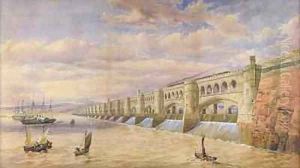Thomas Fulljames Paintings
Thomas Fulljames was an English architect known for his work during the 19th century. Born in 1808, Fulljames's career spanned a period of significant change in British architecture, transitioning from the late Georgian period into the Victorian era. His contributions, though perhaps not as widely recognized as some of his contemporaries, played a significant role in the architectural landscape of his time.
Fulljames began his career in the early 1830s, initially working under the guidance of established architects before eventually establishing his own practice. He was particularly active in the counties of Gloucestershire and Herefordshire, where his work ranged from ecclesiastical buildings to country houses, public institutions, and bridges. His style was eclectic, drawing on a range of historical styles, which was typical of the Victorian period. He was adept at Gothic Revival architecture, a popular style in 19th-century England, which sought to revive medieval Gothic elements.
Among Fulljames's notable projects was the restoration of the Church of St Mary de Lode in Gloucester, where he incorporated Gothic Revival elements to enhance the medieval structure. He also worked on the design of the Gloucester Lunatic Asylum, now known as Horton Road Hospital, which was considered innovative for its time in the way it approached the design of mental health facilities with an emphasis on therapeutic environments.
Throughout his career, Thomas Fulljames was involved in various professional bodies, contributing to the development of architectural practices and standards in Britain. His works are seen as embodying the Victorian spirit of architectural experimentation and adaptation, blending functionality with historical aesthetics.
Thomas Fulljames passed away in 1874, leaving behind a legacy of architectural works that continue to be studied and admired for their historical significance and craftsmanship. His contributions to architecture, particularly in Gloucestershire and Herefordshire, have ensured his place in the annals of British architectural history, reflecting the broader trends and changes of his time.
